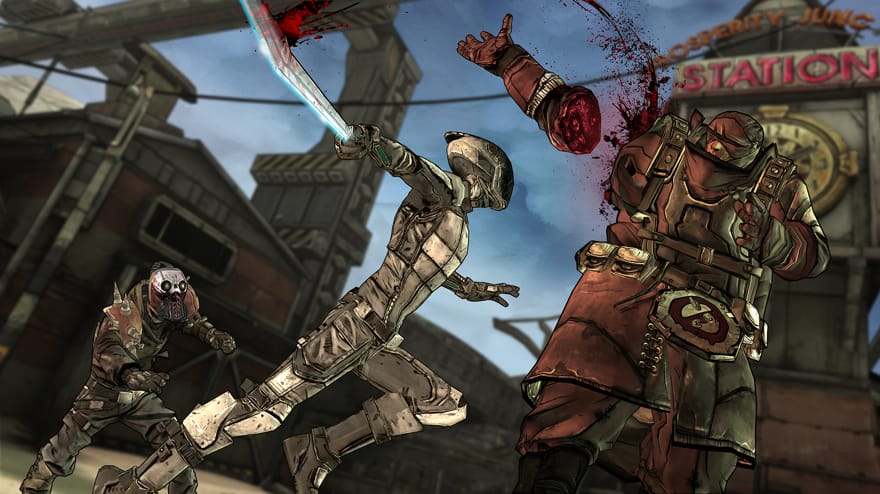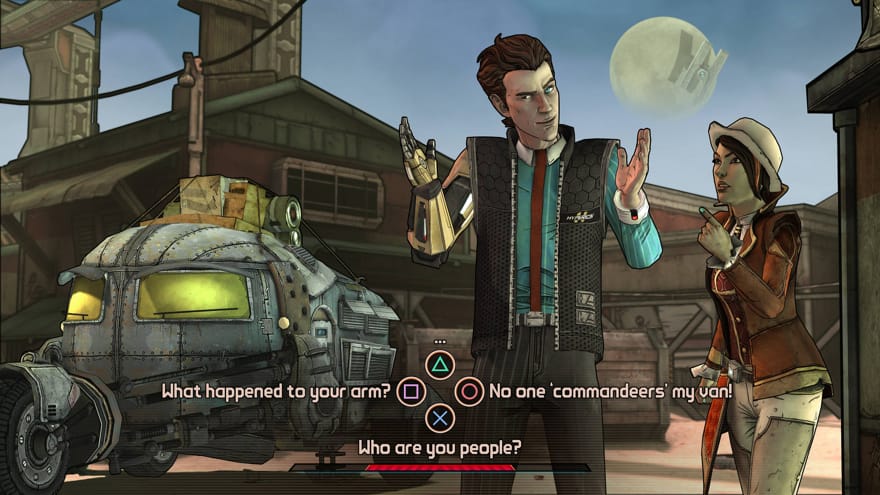Tales from the Borderlands shoots second, asks questions first

For a series devoted to the mindless slaughter of waves of cannon fodder in pursuit of bigger and louder weapons, Borderlands has hinted at the idea of an expansive (if silly) sci-fi universe hiding under the surface. To me, it always seemed like Star Wars where everyone, not just Han, shot first, or Dune, but without all that mythology getting in the way of the awesome fuckin’ sandworms.
The upcoming Tales from the Borderlands by Telltale Games builds upon that mythos, but without the series’ trademark explosive shotguns and grenade-launching pistols.
Telltale’s trajectory through other creators’ worlds has spanned a broad spectrum since their start. But from early experiments with Monkey Island and Strong Bad, through more recent, darker fare like The Walking Dead and The Wolf Among Us, their releases have always felt like “A Telltale Game,” despite the set dressing. Whether you were shooting zombies, looking for Doc Brown or solving a fairy tale murder, most of what you were doing felt relatively similar.
And that’s not a bad thing—I’ve yet to meet anyone who didn’t fret over their choices as Lee. As a newcomer to the Borderlands world, Tales from the Borderlands felt a bit off-putting, though. The shooting scenes in The Walking Dead always seemed a nice break in the conversation, but overall a little anemic; are they planning on hanging an entire game on them?

I was playing the game with Job Stauffer, director of PR for Telltale. The demo, which takes places after Borderlands 2, followed a slick-talking man named Rhys and his milquetoasty companion Vaughn (voiced by nerdom’s Ryan Seacrest, Chris Hardwick) as they head to Pandora to scam a fellow coworker out of a business deal. Cramming a series so intent on looting and shooting into Telltale’s story-driven, point-and-click style seems designed to raise eyebrows, but the way Stauffer sees it, “Some people really aren’t into shooters. The Borderlands universe is so ripe and so much fun to work in, this helps introduce people to how crazy and fun the world is. It’s a kind of an exchange of audiences.”
By placing us in the well-polished shoes of a few office drones and not the series’ typical mercenaries, we get an outsider’s view of Pandora’s gory excesses. After running over a Slag in the demo’s introduction, Rhys and Vaughn fret over the moral implications of kinda-sorta killing something … before shrugging their shoulders and driving off.
Life (and death) goes on. Even if the series’ original designers at Gearbox aren’t directly writing the story, Telltale has kept the series’ meta-humor intact.
We get an outsider’s view of Pandora’s gory excesses.
True to Telltale’s form, dialogue choices along the way allow the player to shape the course of the story. For example, after a robot sent to help Rhys is too damaged to move, does he send it back for repairs or have it self-destruct to take out his pursuers? Did Fiona see a warlord bust in on the business deal, or was the priceless Vault Key actually a fake?
In a storytelling wrinkle one part Rashomon, one part True Detective, players experience Rhys and Fiona’s differing take on what happened via narration to a mysterious third party, so the player can’t trust anything they’re seeing happen as fact.
To make sure every option feels right, Stauffer stressed the D&D tactics in Telltale’s approach to characters, rather than binary good/evil conventions often seen in games. Telltale playtests around a table with a dungeonmaster reading set descriptions and a member of the staff chosen to “play” the game before anything’s even been coded to ensure choices feel realistic and actions make sense.

As Stauffer put it, “How your character behaves will be different than how other people’s will, but you’ll still walk away with the same impression and idea of who Rhys is, or who Fiona is.” He likened it to pen and paper RPGs, where classes have base characteristics yet different personalities; players brings the creative spark to determine just who their character will be.
My Rhys handled the fated business deal like a calm, cool, sci-fi Don Draper negotiating with a waffling client, but if you think he’d bend over backwards, even using bodily force to get that Vault Key, well … you can do that too. What we’re left with is an experience that looks to toe the line between a point-and-click adventure and an all-out action game. The full game is due out later this fall.



